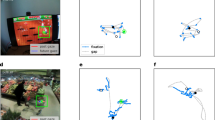Summary
Optokinetic stimuli allow for two perceptual interpretations. The observer may perceive himself as being stationary in a moving surround (egocentric motion perception) or he may experience an illusion of self-motion, so that the actually moving surroundings appear to be stable (exocentric motion perception).
Results
-
1.
Circular motion of the entire surroundings (rotating drum) invariably leads to an apparent self-rotation (circularvection: CV), which is indistinguishable from an actual chair rotation.
-
2.
Following stimulus onset, CV begins after a few seconds latency and slowly increases its apparent velocity until its saturation. CV may outlast the visual stimulus by as much as 30 sec. Latencies are independent of stimulus velocity.
-
3.
Even with drum accelerations up to 15°/sec2, stationary subjects cannot infer from the lack of vestibular input that only the drum is rotating.
-
4.
With stimulation of the entire visual field or sufficiently large parts of the peripheral retina, the velocity of apparent self-rotation matches stimulus speed up to 90–120°/sec. At higher speeds, CV velocity lags behind stimulus speed and results in additional egocentric motion perception.
-
5.
Masking the central visual field by black disks up to 120° in diameter scarcely diminishes CV. Conversely, if peripheral vision is precluded, stimulation of the central field up to 30° in diameter results in exclusive egocentric motion perception of the surround. With a central and peripheral stimulus equivalent in area, the peripheral stimulus predominates CV.
-
6.
Simultaneous presentation of conflicting central and peripheral optokinetic stimuli (i.e., stimuli rotating in opposite directions) has shown that exocentric orientation depends on the peripheral stimulus whereas optokinetic nystagmus and egocentric motion perception rely on the center of the visual field.
Similar content being viewed by others
References
Brandt, Th., Wist, E., Dichgans, J.: Optisch induzierte Pseudo-Coriolis Effekte und Circularvektion. Ein Beitrag zur optisch vestibulären Interaktion. Arch. Psychiat. Nervenkr. 214, 365–389 (1971).
—, Dichgans, J.: Circularvektion, optische Pseudo-Coriolis Effekte und optokinetischer Nachnystagmus: Eine vergleichende Untersuchung subjektiver und objektiver optokinetischer Nacheffekte. Albrecht v. Graefes Arch. klin. exp. Ophthal. 184, 42–57 (1972).
—, Koenig, E.: Perception of self-rotation (circularvection) induced by optokinetic stimuli. Pflügers Arch. 332, R98 (1972).
Dichgans, J., Körner, F., Voigt, K.: Vergleichende Skalierung des afferenten und efferenten Bewegungssehens beim Menschen: Lineare Funktionen mit verschiedener Anstiegssteilheit. Psychol. Forsch. 32, 277–295 (1969).
—, Brandt, Th.: Visual-vestibular interaction and motion perception. In: J. Dichgans and E. Bizzi (Eds.). Cerebral Control of Eye Movements and Motion Perception. Basel-New York: S. Karger 1972.
Dichgans, J., Brandt, Th., Dichgans, J. Brandt, Th. Pseudo-Coriolis-effects and optokinetic motion sickness induced by moving visual stimuli, (in preparation).
—, Held, R., Young, L.R., Brandt, Th.: Moving visual scenes influence the apparent direction of gravity. Science 178, 1217–1219 (1972).
Duensing, F., Schäfer, K.P.: Die Aktivität einzelner Neurone im Bereich der Vestibulariskerne unter besonderer Berücksichtigung des vestibulären Nystagmus. Arch. Psychiat. Nervenkr. 198, 224–252 (1958).
Fischer, M.H., Kornmüller, A.E.: Optokinetisch ausgelöste Bewegungswahrnehmungen und optokinetischer Nystagmus. J. Psychol. Neurol. (Lpz.) 41, 383–420 (1931).
Groen, J.J.: The problems of the spinning top applied to the semicircular canals. Confin. neurol. (Basel) 21, 454–455 (1961).
Gurnee, H.: The effect of a visual stimulus upon the perception of bodily motion. Amer. J. Psychol. 43, 26–48 (1931).
Helmholtz, H.: Handbuch der physiologischen Optik, Vol. III, 3. Aufl. Hamburg-Leipzig: L. Voss 1910.
Jung, R.: Nystagmographie: Zur Physiologie und Pathologie des optisch-vestibulären Systems beim Menschen. In: G. v. Bergmann, W. Frey u. H. Schwiegk (Eds.). Handbuch der Inneren Medizin, 4. Aufl., Bd. V/1, S. 1325–1379. Berlin-Göttingen-Heidelberg: Springer 1953.
Klinke, R., Schmidt, C.L.: Efferent influence on the vestibular organ during active movement of the body. Pflügers Arch. 318, 325–332 (1970).
Körner, F., Dichgans, J.: Bewegungswahrnehmung, optokinetischer Nystagmus und retinale Bildwanderung. Der Einfluß visueller Aufmerksamkeit auf zwei Mechanismen des Bewegungssehens. Albrecht v. Graefes Arch. klin. exp. Ophthol. 174, 34–48 (1967).
Mach, E.: Die Analyse der Empfindungen, 9. Aufl. Jena: G. Fischer 1922.
Stevens, S.S.: On the psychopliysical law. Psychol. Rev. 64, 153–181 (1957).
Uemura, T., Cohen, B.: Vestibulo-ocular reflexes; effects of vestibular nuclear lesions. In: A. Brodal and O. Pompeiano (Eds.). Progress in Brain Research, 37, Basic Aspects of Central Vestibular Mechanisms. Amsterdam: Elsevier 1972.
Author information
Authors and Affiliations
Additional information
Research supported by Deutsche Forschungsgemeinschaft, Sonderforschungsbereich 70 („Hirnforschung und Sinnesphysiologie”).
Rights and permissions
About this article
Cite this article
Brandt, T., Dichgans, J. & Koenig, E. Differential effects of central versus peripheral vision on egocentric and exocentric motion perception. Exp Brain Res 16, 476–491 (1973). https://doi.org/10.1007/BF00234474
Received:
Published:
Issue Date:
DOI: https://doi.org/10.1007/BF00234474




